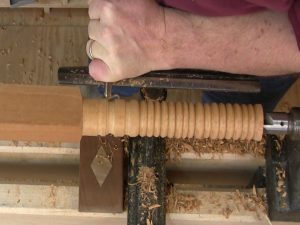 Last week I introduced you to the skew, and this week I’m going to add the spindle gouge. Learning how to make both tools cut (as opposed to scraping) is essential if you want to produce the highest quality turned surfaces.
Last week I introduced you to the skew, and this week I’m going to add the spindle gouge. Learning how to make both tools cut (as opposed to scraping) is essential if you want to produce the highest quality turned surfaces.
Cutting with a skew and gouge is also faster than scraping. I know you say you don’t care how long a project takes. But wouldn’t it be more fun to get done sooner? If you’re cutting with a skew or gouge the surface left behind will be a lot closer to finish ready, which means less sanding. And who doesn’t want to sand less?
The Skew & The Gouge in Action
 Getting the gouge to cut is nearly the same as getting the skew to cut. You’ve got to work the tool up on edge, so the cut is sheer. The minute you lay the tool down flat, you start to scrape, and that’s not a good thing.
Getting the gouge to cut is nearly the same as getting the skew to cut. You’ve got to work the tool up on edge, so the cut is sheer. The minute you lay the tool down flat, you start to scrape, and that’s not a good thing.
Here’s the thing, when you’re cutting a hollow with a gouge you have to approach it from both sides. In the end, that means the very bottom of the cove is scraped. That’s because there’s no way to make the transition from one half to the other without laying the tool down flat. That said, the more you practice cutting with a gouge, the smaller that area becomes.
The video picks up right where I left off last week and expands on the skew. I give you some simples exercises to get you going with the skew followed by similar exercises for the gouge. If there’s something you don’t understand, or you’d like me to expand upon, let me know in the comments.
And if you like the video, head to my YouTube channel and subscribe. Be sure to ring the bell so you don’t miss any of my new videos.